Baled silage has never been as popular on Irish farms. The need for low-height high-protein grass has forced many farmers into knocking out more mature paddocks for baled silage.
The weather also has a big bearing on the amount of bales wrapped in any year. Regardless of what the situation is, the most important function of the wrapping process is to apply the film correctly to ensure the ensiling process is successful. The modern bale chamber also packs in more grass, leading to a heavier and bigger bale. With that in mind, it is absolutely essential to get coverage on the bale.
Getting the grass right
Mowing in the evening time is generally accepted as the best time as the sugar levels are at their highest.
Padraig O’Kiely, grass silage expert with Teagasc, explained that preparation is key to making good-quality baled silage. He said a sugars test should be carried out before you cut to check if the grass is fit for ensiling. Teagasc centres around the country will facilitate this – just bring in a sample of grass and they will do the rest.
Once sugars are above 3%, the grass is OK for ensiling. Sugars will increase if the grass is tedded out in fine weather. Padraig stated that a simple step of waiting until the dew is gone off the grass before you mow a field can reduce up to a tonne of extra weight in water being ensiled.
Philip Cosgrave from IAS laboratories offers a quick turnaround on pre-mowing tests for silage. The test analyses nitrate and sugar levels to help make the decision.
High nitrate level will act as a buffer to pH which can affect the lactic acid fermentation desirable for quality grass. Nitrate levels can be high where the application of N has not been fully utilised by the growing silage crop.
According to Philip, in a typical example, 80 units of N applied will typically take 40 days and one week before mowing. Higher DM grass will ferment at a higher pH. If the sample is in the lab by 12 noon the results are available that evening for farmers. The tests cost €20 for nitrates and €10 for sugars.
Heavy grass swards not tedded out will not reach their potential to wilt effectively in 24 hours. Ideally, the dry matter in the grass should be between 30-35% for baling.
It is advisable that the mower swath boards are opened out to let the grass fall in wide rows between the wheel tracks. For haylage, the common saying is “a day off hay” and up to 60% DM is needed.
Mowers, rakes, and tedders
Setting up the mowers, rakes and tedders is the primary objective of the operator. Machines that are cutting and raking soil are of no benefit. The bacteria in the soil cause butyric acid fermentation not desirable for fermentation.
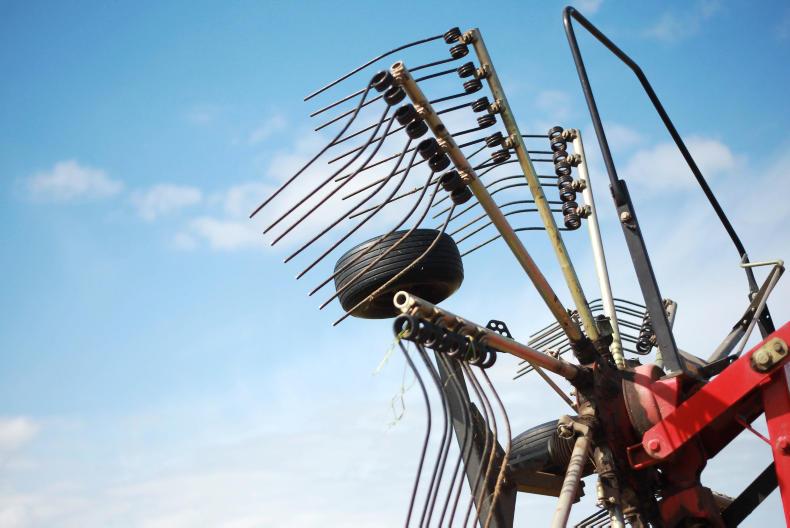
It is important that the rakes and tedders are not throwing soil into the sward. The machines need to cover the ground effectively, not losing any of the grass crop, and also allowing them flow over the cut grass. Bumpy undulating fields cause difficulties in achieving this.
Mowing too tight to the ground can also have a negative effect. The butt of the grass may have old material that may favour mould development in the bale. Also, tightly mown paddocks will take longer to regenerate grass. The suspension system needs to be adjusted to allow the mower float. Raking grass in to windrows for baling needs to be uniform, with no lumps. A consistent row in terms of grass volume and width will always make the best bales.
Baling
Modern balers are a great weapon in grass; most machines can gobble 20ft swaths. To ensure a consistent chop, it is very important that as much of the grass as possible is presented at a right angle which allows the knives to cut it across the intake.
Driving excessively fast will force grass through the cutting system, preventing a good chop action. High speed will also lead to poor bale formation in some cases, leaving saggy bales during the winter.
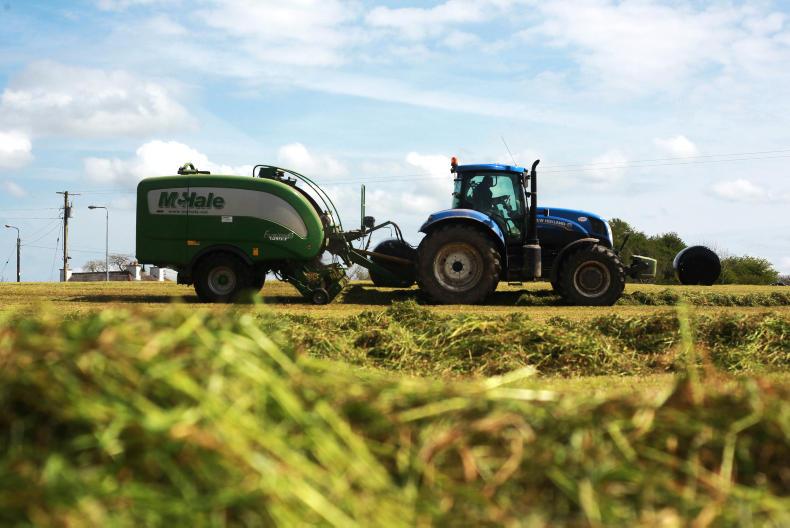
For the wrapper to work well, the bales must be well-formed and square on each side. Bales that are packed more on one side create difficulty for stacking and wrapping. Poor bale shape can also lead to incorrect overlap with film. Weaving across a narrow swath can eliminate this. Not skimping on net is vital to ensuring the bale keeps its shape on the wrapping table.
The wrapper setup
Nearly all wrappers are designed to apply a 70% stretch on the plastic during the wrapping process. The plastic should also have a 50% overlap on each layer that is applied. Typically eight revolutions of the standard wrapper should cover the bale completely. A number of factors can contribute to this not happening:
Incorrect tension setting on the rollers of the wrapper.Problems with the film roll, such as poor winding in the manufacturing process.No tack or glue leads to the film being loose on the bale. This is a manufacturing problem and easily identified. The familiar swish sound is gone when peeling the film off the roll.Tack build-up on the pre-stretch unit (PSU) rollers, especially in hot weather, causes the plastic to slip and is not stretched as much as it should be.Necking down is when the film is pulled too much by the wrapper. This leads to the film losing its height and therefore the overlap. This can result in film tearing at the start of the wrapping cycle. Too much tack on the film can also cause this problem.The height of the PSU mast is incorrect, not giving the overlap on the bale.The belt on the machine’s table has the incorrect tension.Roller cleaning
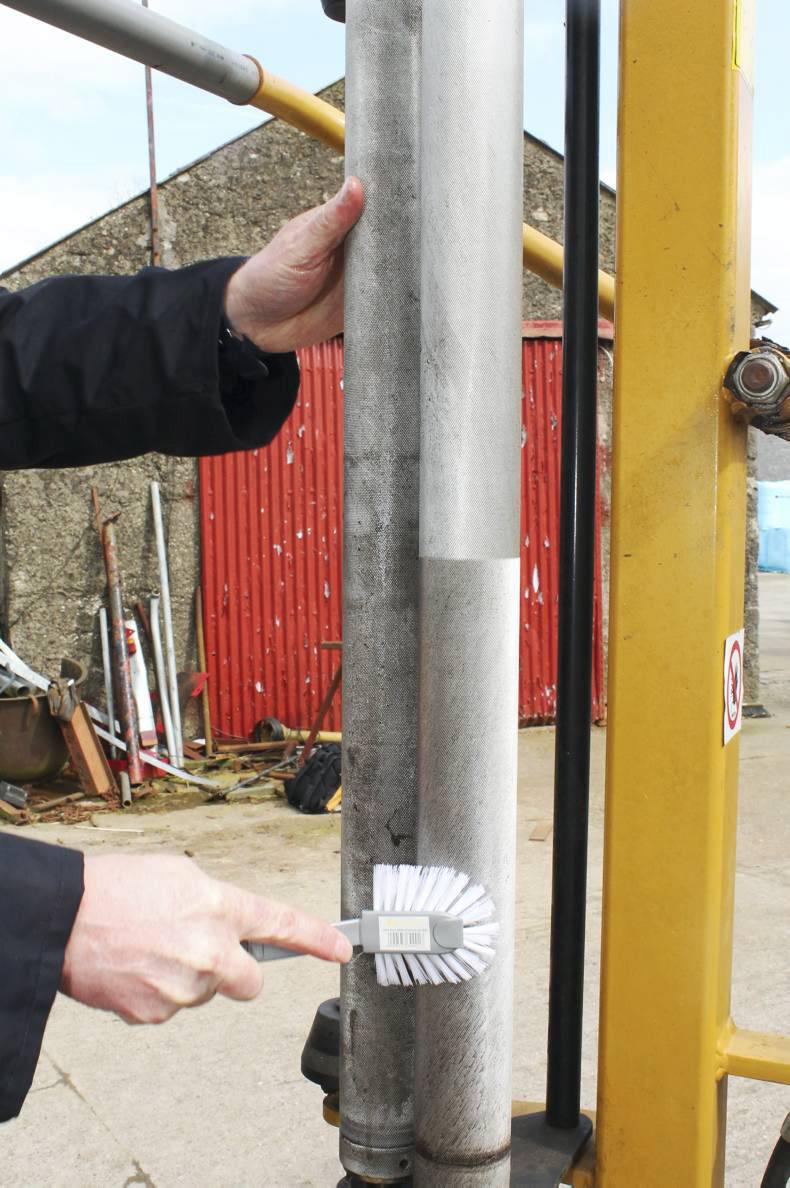 As said earlier, the pre-stretch roller mechanism stretches the plastic by 70% before it is applied to the bales. How do you know when or how often to clean the rollers? If your hand sticks to the roller or rollers, then cleaning them with white spirits is advisable. Similarly, if there are tack and dirt lines at the top and bottom of the rollers then they need cleaning. Heavy grime requires the assistance of a wire brush to clean.
As said earlier, the pre-stretch roller mechanism stretches the plastic by 70% before it is applied to the bales. How do you know when or how often to clean the rollers? If your hand sticks to the roller or rollers, then cleaning them with white spirits is advisable. Similarly, if there are tack and dirt lines at the top and bottom of the rollers then they need cleaning. Heavy grime requires the assistance of a wire brush to clean.
The type of film and temperature outside will dictate how frequent this has to be done. Wrapping in the wet or in the evening time will reduce the wrapper’s ability to stretch the film on to the bale.
This problem leads to fewer bales per roll, which adds another hidden expense. Also notable when the plastic slips is that the plastic film is wrinkly as it is applied onto the bale.
Greasing the pre-stretch gears
The pre-stretch rollers are geared to each other to provide the 70% stretch required before the plastic is applied to the bale.
To stretch the film by 70%, there is considerable pressure on the gears and they do require regular greasing. Individual manufacturers will provide their own guidelines, but in general greasing them every 500 to 1,000 bales is advisable. Failure to grease the gears will cause them to run dry and cause problems with film stretch, usually over-stretching, and wearing out the gears. To gain access to the gear set on the top of the dispenser unit requires the cover on top to be removed. This may be held in place by small bolts, clips or screws.
Number of wraps
A minimum of four layers of film should be applied to all parts of the bale. Six layers should be applied if grass dry matter is 35% or greater.
As part of regular maintenance and checks, especially if wrapping bales from different balers with slightly different diameters, it is very important to ensure that four layers of film are applied over the entire bale. Two or three layers in places could result in the bale bursting when being handled or stacked while also affecting the silage quality if not split.
This can be checked on the wrapper by analysing how many turns it takes to cover the bale. 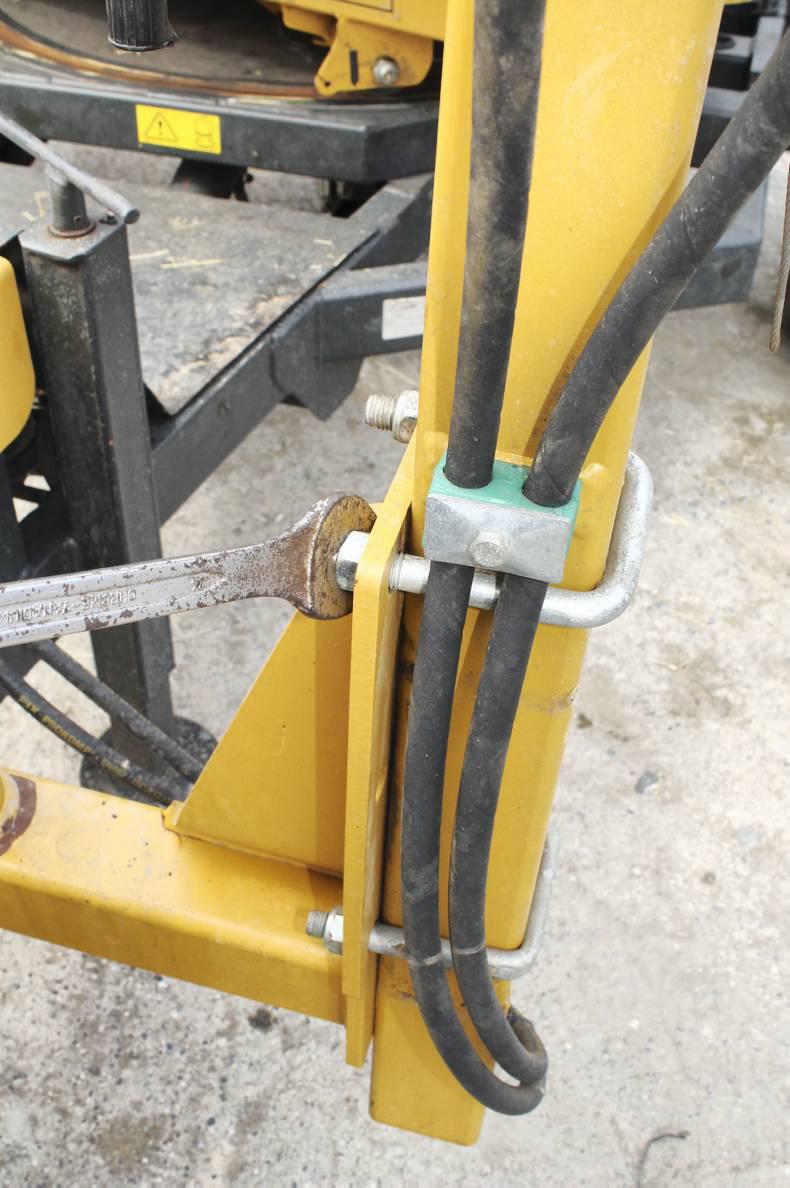 Checking the overlap here is important as the bale is only as strong as the weakest link.
Checking the overlap here is important as the bale is only as strong as the weakest link.
If the height is incorrect on the PSU, parts of the bale could have six layers of film while other parts may only have three. The operator thinks enough film is going on the bale but it’s in the wrong place. Setting it to the correct height allows the bale to be completely covered with two layers on eight revolutions.
One turn saved with the bale correctly wrapped represents almost two extra bales per roll of film. Correct settings are not just important for good-quality silage but also when it comes to managing silage-making costs.
Experiments at both Grange and Oak Park have shown that a minimum of four layers of conventionally applied standard stretch film is required to conserve baled silage adequately.
Teagasc believes that where good management practice prevails, the benefits accruing from progressing to six layers of film are small.
However, where bales may be stored for a prolonged duration, six layers may be advisable.
The production of dense, high dry matter (DM) bales from highly digestible grass, with in excess of 200kg DM per bale, can justify using six layers of film.
Belt sag
Another important adjustment keeping both the bale turning correctly and the film applied in the correct position is the adjustment of belt sag. Turntable designs differ from one manufacturer to another but the vast majority use either a set of belts or one full-width belt. The belts are geared to provide a minimum 50% film overlap on the bale.
Wrapping 10,000 bales per year has had in the region of 7,500t of silage dumped on its belts. After four or five years of this, the belts will certainly need tensioning to bring them back up. The film dispenser must be aligned with it to compensate for the sag.
Too much tightening on the belts can cause the bale to fall off while being wrapped. After tensioning, wrap slowly to see how the bale rotates in its newly elevated position. Tensioning the belts is done on the non-drive rollers, where it does not upset or interfere with the drive rollers, chain drive or drive mechanism.
Bale stacking
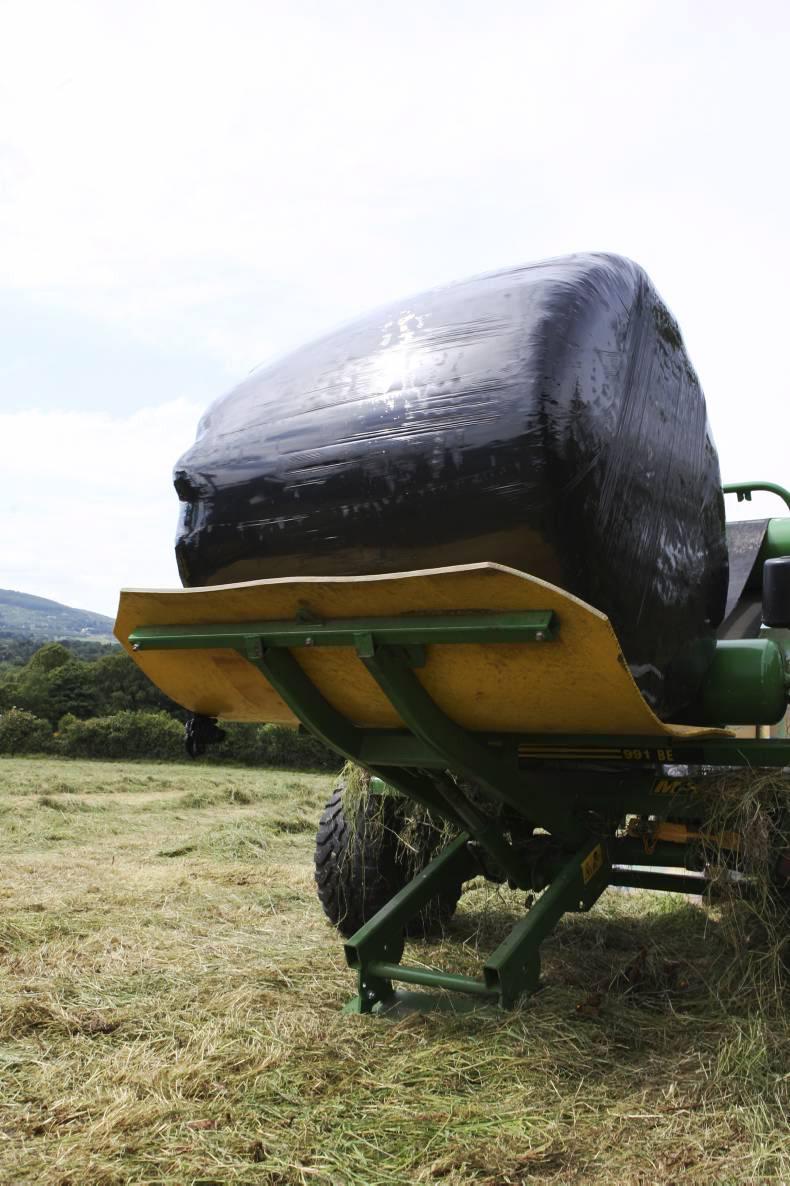 After all that is achieved and the bales are made with good silage and wrapped well, stacking in the yard or in the field is important because this is where the finished product will live until needed.
After all that is achieved and the bales are made with good silage and wrapped well, stacking in the yard or in the field is important because this is where the finished product will live until needed.
Poor stacking is one of the most annoying and avoidable problems with baled silage. If the bale is well formed with good shape, forming a stack is pretty easy.
Saggy bales should not be stacked high. Even at two rows it is not ideal for this type of bale. Stacking bales high leads to tremendous weight on the bottom bale – it can resemble a pancake after a long period in storage.
The dry matter content of the bale is what can govern the height of the stack:
Below 25% dry matter, stack in single layers.Between 25% to 35% dry matter, stack two bales high.Between 35% to 45% dry matter, stack three bales high.Bale stacks should be put in an accessible location all year round away from potential flooding. Crows and birds are the enemy of every bale in the country, and bird deterrents need attention.
Bale nets, covers, paint, grease, are all commonly used to prevent birds landing on the bale. Birds don’t eat grass – they land on it for curiosity and scouting the ground for worms. The damage is often done by the feet of the bird. The stack should be fenced off from animals and a suitable poison laid for vermin.
Read more
Special focus: baled silage
Full coverage: silage 2017
Baled silage has never been as popular on Irish farms. The need for low-height high-protein grass has forced many farmers into knocking out more mature paddocks for baled silage.
The weather also has a big bearing on the amount of bales wrapped in any year. Regardless of what the situation is, the most important function of the wrapping process is to apply the film correctly to ensure the ensiling process is successful. The modern bale chamber also packs in more grass, leading to a heavier and bigger bale. With that in mind, it is absolutely essential to get coverage on the bale.
Getting the grass right
Mowing in the evening time is generally accepted as the best time as the sugar levels are at their highest.
Padraig O’Kiely, grass silage expert with Teagasc, explained that preparation is key to making good-quality baled silage. He said a sugars test should be carried out before you cut to check if the grass is fit for ensiling. Teagasc centres around the country will facilitate this – just bring in a sample of grass and they will do the rest.
Once sugars are above 3%, the grass is OK for ensiling. Sugars will increase if the grass is tedded out in fine weather. Padraig stated that a simple step of waiting until the dew is gone off the grass before you mow a field can reduce up to a tonne of extra weight in water being ensiled.
Philip Cosgrave from IAS laboratories offers a quick turnaround on pre-mowing tests for silage. The test analyses nitrate and sugar levels to help make the decision.
High nitrate level will act as a buffer to pH which can affect the lactic acid fermentation desirable for quality grass. Nitrate levels can be high where the application of N has not been fully utilised by the growing silage crop.
According to Philip, in a typical example, 80 units of N applied will typically take 40 days and one week before mowing. Higher DM grass will ferment at a higher pH. If the sample is in the lab by 12 noon the results are available that evening for farmers. The tests cost €20 for nitrates and €10 for sugars.
Heavy grass swards not tedded out will not reach their potential to wilt effectively in 24 hours. Ideally, the dry matter in the grass should be between 30-35% for baling.
It is advisable that the mower swath boards are opened out to let the grass fall in wide rows between the wheel tracks. For haylage, the common saying is “a day off hay” and up to 60% DM is needed.
Mowers, rakes, and tedders
Setting up the mowers, rakes and tedders is the primary objective of the operator. Machines that are cutting and raking soil are of no benefit. The bacteria in the soil cause butyric acid fermentation not desirable for fermentation.

It is important that the rakes and tedders are not throwing soil into the sward. The machines need to cover the ground effectively, not losing any of the grass crop, and also allowing them flow over the cut grass. Bumpy undulating fields cause difficulties in achieving this.
Mowing too tight to the ground can also have a negative effect. The butt of the grass may have old material that may favour mould development in the bale. Also, tightly mown paddocks will take longer to regenerate grass. The suspension system needs to be adjusted to allow the mower float. Raking grass in to windrows for baling needs to be uniform, with no lumps. A consistent row in terms of grass volume and width will always make the best bales.
Baling
Modern balers are a great weapon in grass; most machines can gobble 20ft swaths. To ensure a consistent chop, it is very important that as much of the grass as possible is presented at a right angle which allows the knives to cut it across the intake.
Driving excessively fast will force grass through the cutting system, preventing a good chop action. High speed will also lead to poor bale formation in some cases, leaving saggy bales during the winter.

For the wrapper to work well, the bales must be well-formed and square on each side. Bales that are packed more on one side create difficulty for stacking and wrapping. Poor bale shape can also lead to incorrect overlap with film. Weaving across a narrow swath can eliminate this. Not skimping on net is vital to ensuring the bale keeps its shape on the wrapping table.
The wrapper setup
Nearly all wrappers are designed to apply a 70% stretch on the plastic during the wrapping process. The plastic should also have a 50% overlap on each layer that is applied. Typically eight revolutions of the standard wrapper should cover the bale completely. A number of factors can contribute to this not happening:
Incorrect tension setting on the rollers of the wrapper.Problems with the film roll, such as poor winding in the manufacturing process.No tack or glue leads to the film being loose on the bale. This is a manufacturing problem and easily identified. The familiar swish sound is gone when peeling the film off the roll.Tack build-up on the pre-stretch unit (PSU) rollers, especially in hot weather, causes the plastic to slip and is not stretched as much as it should be.Necking down is when the film is pulled too much by the wrapper. This leads to the film losing its height and therefore the overlap. This can result in film tearing at the start of the wrapping cycle. Too much tack on the film can also cause this problem.The height of the PSU mast is incorrect, not giving the overlap on the bale.The belt on the machine’s table has the incorrect tension.Roller cleaning
 As said earlier, the pre-stretch roller mechanism stretches the plastic by 70% before it is applied to the bales. How do you know when or how often to clean the rollers? If your hand sticks to the roller or rollers, then cleaning them with white spirits is advisable. Similarly, if there are tack and dirt lines at the top and bottom of the rollers then they need cleaning. Heavy grime requires the assistance of a wire brush to clean.
As said earlier, the pre-stretch roller mechanism stretches the plastic by 70% before it is applied to the bales. How do you know when or how often to clean the rollers? If your hand sticks to the roller or rollers, then cleaning them with white spirits is advisable. Similarly, if there are tack and dirt lines at the top and bottom of the rollers then they need cleaning. Heavy grime requires the assistance of a wire brush to clean.
The type of film and temperature outside will dictate how frequent this has to be done. Wrapping in the wet or in the evening time will reduce the wrapper’s ability to stretch the film on to the bale.
This problem leads to fewer bales per roll, which adds another hidden expense. Also notable when the plastic slips is that the plastic film is wrinkly as it is applied onto the bale.
Greasing the pre-stretch gears
The pre-stretch rollers are geared to each other to provide the 70% stretch required before the plastic is applied to the bale.
To stretch the film by 70%, there is considerable pressure on the gears and they do require regular greasing. Individual manufacturers will provide their own guidelines, but in general greasing them every 500 to 1,000 bales is advisable. Failure to grease the gears will cause them to run dry and cause problems with film stretch, usually over-stretching, and wearing out the gears. To gain access to the gear set on the top of the dispenser unit requires the cover on top to be removed. This may be held in place by small bolts, clips or screws.
Number of wraps
A minimum of four layers of film should be applied to all parts of the bale. Six layers should be applied if grass dry matter is 35% or greater.
As part of regular maintenance and checks, especially if wrapping bales from different balers with slightly different diameters, it is very important to ensure that four layers of film are applied over the entire bale. Two or three layers in places could result in the bale bursting when being handled or stacked while also affecting the silage quality if not split.
This can be checked on the wrapper by analysing how many turns it takes to cover the bale.  Checking the overlap here is important as the bale is only as strong as the weakest link.
Checking the overlap here is important as the bale is only as strong as the weakest link.
If the height is incorrect on the PSU, parts of the bale could have six layers of film while other parts may only have three. The operator thinks enough film is going on the bale but it’s in the wrong place. Setting it to the correct height allows the bale to be completely covered with two layers on eight revolutions.
One turn saved with the bale correctly wrapped represents almost two extra bales per roll of film. Correct settings are not just important for good-quality silage but also when it comes to managing silage-making costs.
Experiments at both Grange and Oak Park have shown that a minimum of four layers of conventionally applied standard stretch film is required to conserve baled silage adequately.
Teagasc believes that where good management practice prevails, the benefits accruing from progressing to six layers of film are small.
However, where bales may be stored for a prolonged duration, six layers may be advisable.
The production of dense, high dry matter (DM) bales from highly digestible grass, with in excess of 200kg DM per bale, can justify using six layers of film.
Belt sag
Another important adjustment keeping both the bale turning correctly and the film applied in the correct position is the adjustment of belt sag. Turntable designs differ from one manufacturer to another but the vast majority use either a set of belts or one full-width belt. The belts are geared to provide a minimum 50% film overlap on the bale.
Wrapping 10,000 bales per year has had in the region of 7,500t of silage dumped on its belts. After four or five years of this, the belts will certainly need tensioning to bring them back up. The film dispenser must be aligned with it to compensate for the sag.
Too much tightening on the belts can cause the bale to fall off while being wrapped. After tensioning, wrap slowly to see how the bale rotates in its newly elevated position. Tensioning the belts is done on the non-drive rollers, where it does not upset or interfere with the drive rollers, chain drive or drive mechanism.
Bale stacking
 After all that is achieved and the bales are made with good silage and wrapped well, stacking in the yard or in the field is important because this is where the finished product will live until needed.
After all that is achieved and the bales are made with good silage and wrapped well, stacking in the yard or in the field is important because this is where the finished product will live until needed.
Poor stacking is one of the most annoying and avoidable problems with baled silage. If the bale is well formed with good shape, forming a stack is pretty easy.
Saggy bales should not be stacked high. Even at two rows it is not ideal for this type of bale. Stacking bales high leads to tremendous weight on the bottom bale – it can resemble a pancake after a long period in storage.
The dry matter content of the bale is what can govern the height of the stack:
Below 25% dry matter, stack in single layers.Between 25% to 35% dry matter, stack two bales high.Between 35% to 45% dry matter, stack three bales high.Bale stacks should be put in an accessible location all year round away from potential flooding. Crows and birds are the enemy of every bale in the country, and bird deterrents need attention.
Bale nets, covers, paint, grease, are all commonly used to prevent birds landing on the bale. Birds don’t eat grass – they land on it for curiosity and scouting the ground for worms. The damage is often done by the feet of the bird. The stack should be fenced off from animals and a suitable poison laid for vermin.
Read more
Special focus: baled silage
Full coverage: silage 2017


 As said earlier, the pre-stretch roller mechanism stretches the plastic by 70% before it is applied to the bales. How do you know when or how often to clean the rollers? If your hand sticks to the roller or rollers, then cleaning them with white spirits is advisable. Similarly, if there are tack and dirt lines at the top and bottom of the rollers then they need cleaning. Heavy grime requires the assistance of a wire brush to clean.
As said earlier, the pre-stretch roller mechanism stretches the plastic by 70% before it is applied to the bales. How do you know when or how often to clean the rollers? If your hand sticks to the roller or rollers, then cleaning them with white spirits is advisable. Similarly, if there are tack and dirt lines at the top and bottom of the rollers then they need cleaning. Heavy grime requires the assistance of a wire brush to clean. Checking the overlap here is important as the bale is only as strong as the weakest link.
Checking the overlap here is important as the bale is only as strong as the weakest link.  After all that is achieved and the bales are made with good silage and wrapped well, stacking in the yard or in the field is important because this is where the finished product will live until needed.
After all that is achieved and the bales are made with good silage and wrapped well, stacking in the yard or in the field is important because this is where the finished product will live until needed. 











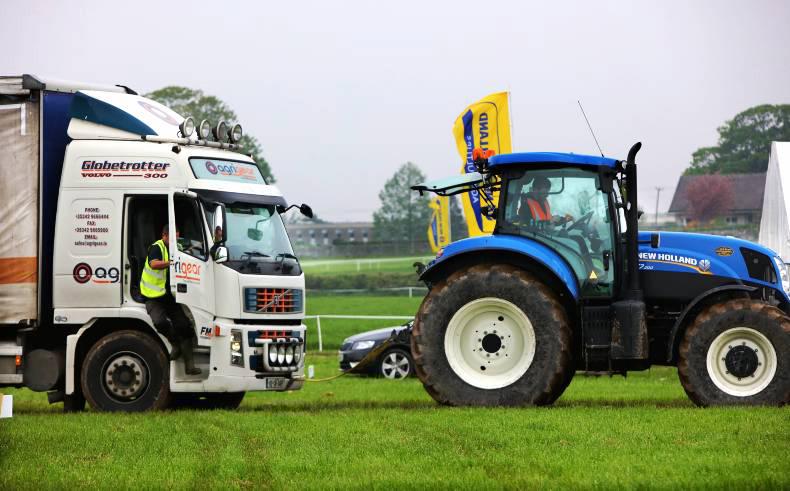
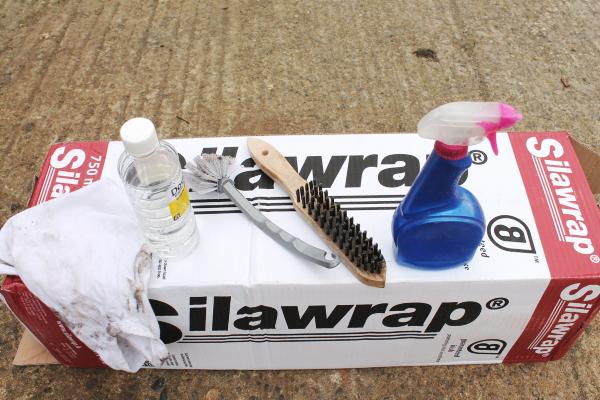


SHARING OPTIONS